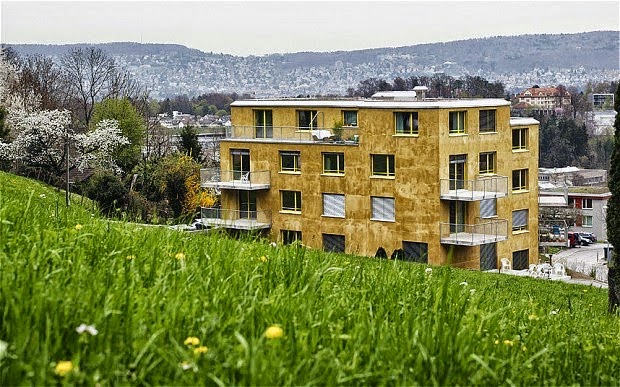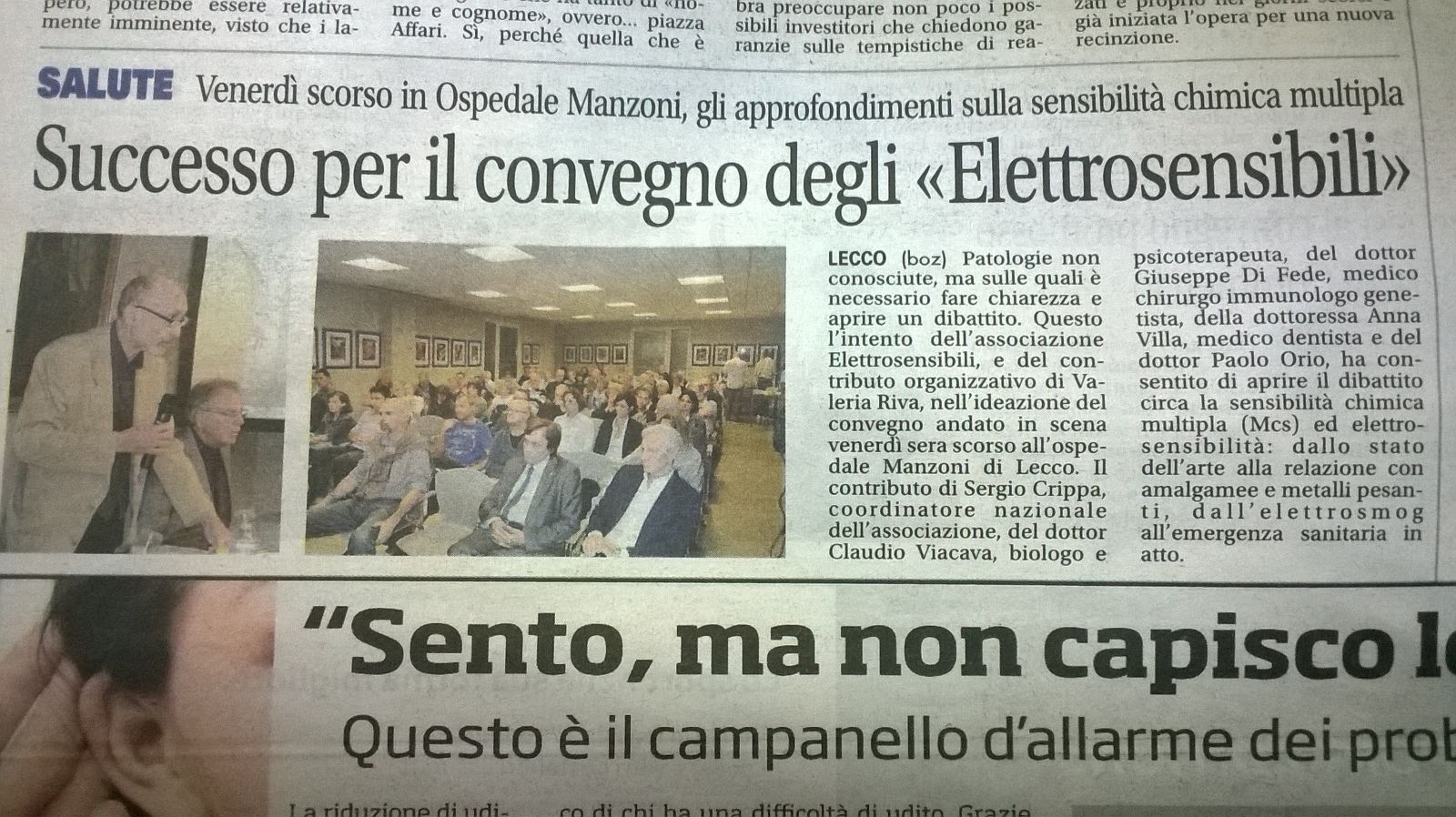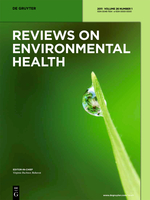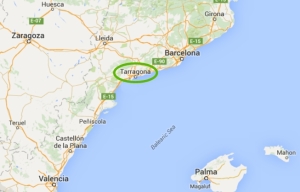Tag: MCS

Documentario inquinamento elettromagnetico
Documentario (Generation Zapped) sull’inquinamento elettromagnetico con interviste a ricercatori internazionali INDIPENDENTI del calibro di Olle Johansson, David Carpenter, Cindy Sage.
I danni alla salute procurati da esposizioni prolungate alle radiazioni elettromagnetiche (assimilabili per potenziali rischi alla salute a piombo,amianto e fumo di tabacco) possono avere conseguenze devastanti come per es. tumori cerebrali e neurinomi dell’acustico.
Il trailer del film: Sensibile
Ecco il trailer del film Sensibile!
“SENSIBILE”(Sensitive) by A. Quadretti – documentary trailer from Officinemedia on Vimeo.
Business executive who claimed spending six hours a day on his mobile gave him brain cancer dies aged 44
20 May 2016 – “www.dailymail.co.uk”, by ANNA HODGEKISS and MADLEN DAVIES FOR MAILONLINE
- Ian Phillips was found to have a lemon-sized tumour on his brain
- Had surgery and chemotherapy but was told he had just 3 years to live
- Campaigned against phones after claiming his mobile caused his cancer
- Family say they have received hundreds of tributes from all over the world
Click the link below to read the article/Cliccare sul link sottostante per leggere l’articolo:
Business-executive-claimed-spending-six-hours-day-mobile-gave-cancer-dies-aged-44
First Municipal Government Adopts Life Saving Plan for People With MCS/ES, CFS/ME, and FM
11 January 2016 – “lindasepp.wordpress.com”
Good news for some people who have MCS/ES, CFS/ME, and FM
RESCUE PLAN FOR PEOPLE WITH CENTRAL SENSITIVITY SYNDROMES:
THE CITY OF TARRAGONA (CATALONIA, SPAIN) IS THE FIRST MUNICIPAL GOVERNMENT THAT IMPLEMENTS IT!
The first municipal government that has stepped forward to implement this plan, is the City of Tarragona Municipal Government (Tarragona is a major city 100 kilometres south of Barcelona). In the plenary session held last November 30th, the “Institutional Declaration of support for people with Central Sensitivity Syndromes” was approved, which consists of a concrete programme of measures. This is a historical step.
In part, the agreement includes:
FIRST. Create and develop a specific support programme for people with CSS and their families in the City of Tarragona, in which the representatives of those affected have to be involved and which will include:
- Carry out (with a yearly update) a diagnosis and census of those affected by CSS in the City of Tarragona, showing what is the actual situation and the specific needs of these patients and their families.
- An intervention protocol for the staff of the Area of Services to Citizens of the Tarragona City Government to look after those with CSS- including a list of economic subsidies for food, first necessity elements, reduced water bill, and home help specific to the needs of these patients.
- Housing protocol for people with CSS, especially those who have MCS and/or EHS, those threatened by eviction or those who are forced to leave their home. This protocol has to include a series of safe social housing (green/white spaces: free of xenobiotics and electromagnetic waves).
- Create green/white spaces in all municipal buildings (free of xenobiotics and electromagnetic waves).
- Eliminate, as much as possible, the use of pesticides in the whole of the municipality. In the case when this is not possible, establish a communication protocol to contact those affected and the press regarding the places and dates of the interventions with preventive advice.
- Training for social workers and educators about CSS, its social, health and economic reality. Elaboration of information and education to increase the knowledge about these illnesses amongst the general population and of the city workers in particular, with the objective of diminishing the stigma that is now present regarding these illnesses.
- Protocol for adapting working conditions of the municipal workers who have CSS with specific measures of support when having a flare up. These would be the measures: work schedule flexibility, encourage work from home through internet (teleworking), reserved parking spaces and include in the collective agreement not deduct the salary of the first 20 days of sick leave.
Read the entire plan here: GOOD NEWS
Source/Fonte:
PROSTITUTING SCIENCE: The Psychologisation of MCS, CFS and EHS for Political Gain – book review
[Quando la scienza si assoggetta ad interessi economici…
Recensione di un libro.]
Author: Diana Crumpler
Publisher: Inkling Australia
Book Publication: 2014
“vitalitymagazine.com”, review by Bonnie Black
 Diana Crumpler, whose first book, Chemical Crisis, received widespread critical acclaim, wrote Prostituting Science – The Psychologisation of MCS, CFS and EHS for Political Gain in memory of a friend and fellow sufferer of Multiple Chemical Sensitivity (MCS) and Chronic Fatigue Syndrome (CFS). They shared “a wonderful 25 year long, hands-across-the-ocean friendship.” Pam lived in Ontario; Diana lives in Australia where she worked as a teacher and librarian until she retired in 1984 due to ill health.
Diana Crumpler, whose first book, Chemical Crisis, received widespread critical acclaim, wrote Prostituting Science – The Psychologisation of MCS, CFS and EHS for Political Gain in memory of a friend and fellow sufferer of Multiple Chemical Sensitivity (MCS) and Chronic Fatigue Syndrome (CFS). They shared “a wonderful 25 year long, hands-across-the-ocean friendship.” Pam lived in Ontario; Diana lives in Australia where she worked as a teacher and librarian until she retired in 1984 due to ill health.
Taking up from where Rachel Carson’s Silent Spring left off, Prostituting Science delves into the subject of non-communicable diseases plaguing society today. Based on the understanding that illnesses like ADHD, autism, Alzheimer’s, Parkinson’s, depression, schizophrenia, MCS, EHS (electromagnetic hyper-sensitivity), and CFS are more than just diseases of our civilization, Crumpler asserts they are by-products of our reliance on chemo- and electro-wizardry, and she presents credible, authoritative evidence to support her claim.
In the introduction, Crumpler writes, “Welcome to the world of alien refugees: the world of the chemically and electrically hypersensitive, aliens within their own civilization, refugees from the realm of twenty-first century chemo- and techno-wizardry. For such people, ‘going green’ is not an ideological or a philosophical choice; rather, it is their only feasible modus vivendi, their only way to wellness, and for some, the only means of survival. It is a world that I, myself, know all too well, having inhabited that hell-hole for the best part of my life.”
In addition to an impressive collection of scientific data, the author shares the story of her own family’s descent into the disabling illness of MCS, CFS, and EHS – all of which were a consequence of exposure to heavy pesticides. Skeptics may be dismayed to learn that these pages contain all the evidence needed to convince even the most hardened among them that all of the above-mentioned diseases are bona fide physiological disorders.
But Crumpler does not stop there. She includes an extensive Glossary, References, Index list, and effective treatment protocols for recovery. She also documents gross abuse of civil and human rights – including the author’s abduction and committal under an involuntary psychiatric treatment order on the grounds that “MCS and EHS do not exist” and that “to believe in their physicality constitutes a delusion and, hence, a manifestation of psychosis.”
Prostituting Science details one family’s battle with MCS, CFS, and EHS. The book also explores the mechanisms behind these diseases and their allied disorders and explains the paradox whereby the more that is known of a cause of any of these three illnesses, the more vehement and widely accepted have become allegations of what is called psychogenesis (the origin of symptoms seen as a result of emotional [versus physiological] causes). Crumpler refutes these allegations and takes the risk of publicly declaring her belief instead in the physicality of MCS and EHS. She writes, “Only by speaking out, by making MCS, CFS, and EHS issues of public concern can we create the climate of awareness necessary to prevent being done to others (possibly with fatal results) what was done to me. To allow oneself to be cowed into silence is to betray the memory of the many friends already dead from these, the most physical of illnesses.”
Writer Pelda B. Hyman called Prostituting Science “A monumental and perhaps the most inclusive work ever on MCS and EHS.” But I think the last word should go to the author, whose dedication includes this tribute: “To Owen, Belle, Jordan, Fraser, April, Emily, and Sebastian, our hopes for the future, in the hope that hard-won awareness will allow your futures to be all that we had once planned our own to be. And in memory of my father, Francis Denis Connellan (1904 – 1979), field naturalist and campaigner for environmental awareness in the days before that term had become a buzz word.”
To purchase a copy of Prostituting Science, send an email to: bernie.crumpler@gmail.com
Source/Fonte:
Switzerland: Zurich: The First European Refuge for Electrosensitive People
[Articolo un po’ datato che tratta del primo rifugio Europeo per persone affette da Elettrosensibilità e Sensibilità Chimica Multipla, costruito a Zurigo e completato nel dicembre del 2013.]
15 August 2014 – “mieuxprevenir.blogspot.co.uk”
We do not wish to discourage the initiator of this project, but it seems that the site is badly polluted with cell phone tower radiation. The article, however, describes well the plight of people living with chemical and electromagnetic sensitivities.
In Zurich, the first European refuge for electrosensitive people
by Solène Cordier, Le Monde, 12 August 2014 (translated by the Editor of this blog)
At first glance, nothing distinguishes this apartment building in the suburbs of Zurich from those surrounding it. Located on the heights of the quiet neighborhood of Leimbach, its sand-colored walls are surrounded by a vast garden of tall grasses. The big trees of the forest of Entlisberg, perched on the adjacent mountain, extend their refreshing shade to the surrounding area.
It is because of the particular setting that the building, destined to welcome people suffering from multiple chemical hypersensitivity (MCS) and electrosensitivity, has been constructed in this location. “Five sites were studied in the beginning,” says Christian Schifferle, the initiator of the project. “Measurements showed that this site was radiated very little thanks to the nearby mountain which offers a protective environment.” The absence of antennas was also a precondition for construction, as well as air quality.
Headaches, chronic fatigue, difficulties concentrating, respiratory problems, depression, food intolerances… the list of disorders of the 14 residents is long. “We do not tolerate fumes from chemical products and electromagnetic wave emissions coming from wireless networks,” says Mr. Schifferle.
At age 59, he says he has been hyper-allergic and electrosensitive since childhood. His suffering has constrained him to live for long periods alone in the forest in a caravan with walls covered in aluminum foil. At that time, all odors assaulted him: perfumes, cleaning products, paints, cigarette smoke… At age 35, he discovered in the press that other people suffered the same symptoms which, when they reached a critical level, constrained these sick people to interrupt all professional and social life. With only his disability pension, Christian decided to fight for recognition of his pathology.
« Today, this building symbolizes our emergence from invisibility, » he says with emotion, « even if in Switzerland as in France, MCS and electrohypersensitivity are not recognized officially as diseases.
A total cost of 4.9 million euros
Completed in December 2013, this first anti-allergic apartment building in Europe cost 6 million Swiss francs (4.9 million euros), the materials and technologies used raising the cost around 25% compared to the usual apartment building in Zurich. The cooperative presided over by Christian Schifferle has benefited from the support of the city which furnished the land of 1,200 square meters and financial aid.
When one goes inside the building, some details betray its specificity. The walls of the common areas painted with lime, the ceilings of raw concrete, and the floor in stone leave an impression of being unfinished. The natural materials were given preference by the architects, who received the support of a chemist during construction. “It is the plaster used for the walls which posed the most difficulty. It was necessary to reduce the additives in order that for it to be tolerated by the residents,” explains the architect, Andreas Zimmermann.
In order to provide protection from electromagnetic waves, fiberglass was used in place of the usual metallic frame. At the entrance of each apartment, a sealed-off area has been foreseen to remove clothes that have too much of an odor and each room is equipped with a system of air purification. In the basement, next to the communal washing machine, there are authorized detergents and cleaning products, all labeled, “odorless” and “without dyes”.
The day before our arrival, Mr. Schifferle explained the rules: no cell phone, no smoking, no perfume is tolerated inside the building. “I have two smartphones but they are nearly all the time in “airplane” mode. I use them to take photos, one of my passions,” says Christian. For communication related to his activity as president of the cooperative and of a foundation for recognition of MCS and electrosensitivity, he uses a corded telephone and a computer connected by cable to the Internet.
Moreover, a special shielding covers all the electric cables in the building which has a minimum number of outlets. Differing from other electrosensitive people, the intolerance of the residents to waves concerns only high frequencies (mobile phones and Wi-Fi).
An inexistent social life
For Christian as well as his 13 neighbors, this place serves as a refuge. Conceived as a Faraday cage, it allows each person to recharge his/her batteries and hope to again return to normal activities.
Marc (his first name has been changed) is 32 years old. Originally from Fribourg, he moved here in April. Like Christian, he receives a disability pension for reasons other than electrosensitivity and MCS. However, after several experiments, he arrived at the conclusion that his exhausted state was very likely due to exposure to waves and chemical products. “They diagnosed me with anxiety disorder, but I believe that this is not the cause but a consequence of my fragility,” he explains.
The victim of severe digestive disorders, chronic exhaustion and food allergies since childhood, Marc had to abandon his studies at age 22. He has never succeeded in holding down a job for more than several months. A year ago, he discovered that his condition substantially improved when he was not in contact with waves. “I slept on many occasions in the cellar of my parents, then I went to live for some time at a farm in the Jura,” he confided, before learning through his brother of the existence of an apartment building project in Leimbach and submitting his application.
Since settling in, he has the impression that his state of health has slightly improved. To his great surprise, in arriving in Leimbach, he met several persons his age. His neighbors include a 28-year-old woman who has been living there since the beginning of the year with her companion who does not suffer from any pathology.
With the exception of the latter person, in order to obtain an apartment, all the residents of the building have had to justify their symptoms by presenting a medical certificate. Certain social criteria are also required to benefit from an apartment whose monthly rent is between 1,300 and 1,600 Swiss francs (1,000 and 1,400 euros), in great part borne by the city of Zurich.
The city of Zurich is awaiting the results of an evaluation conducted by the University of Bern of the inhabitants of this pilot project for an eventual repetition of the experiment. Christian Schifferle has already looked at land in the Ticino and in France on the Côte d’Azur. “For people like us, it would be wonderful to imagine being able to go on vacation”, he says, smiling.
Solène Cordier, Le Monde journalist
Original article/Articolo originale:
Source/Fonte:
http://mieuxprevenir.blogspot.co.uk/2014/08/switzerland-zurich-first-european.html
Reliable disease biomarkers characterizing and identifying electrohypersensitivity and multiple chemical sensitivity as two etiopathogenic aspects of a unique pathological disorder
[Importantissimo studio del prof. Belpomme, finalmente pubblicato ma non ancora open-source, che si spera metterà freno al mare di bugie dette sinora riguardo ad EHS e MCS, in quanto ha individuato dei marker di malattia e soprattutto ha messo questi ultimi rispettivamente in relazione con la esposizione ai CEM e alle sostanze chimiche.
Ergo adesso sarà molto più difficile, per certune persone, AFFERMARE FALSAMENTE che non esistono prove delle suddette relazioni e che, nel caso della EHS, alla base di tutto ci sia l’EFFETTO NOCEBO.
Basta bugie! Perché i malati di EHS e MCS non possono continuare a pagare il fatto di avere delle malattie scomode!
La traduzione in Italiano dell’ABSTRACT segue l’ABSTRACT stesso.]
Rev Environ Health. 2015 Dec 1;30(4):251-71. doi: 10.1515/reveh-2015-0027.
By:
Belpomme D, Campagnac C, Irigaray P.
ARTICLE INFO
Article history
Received: 11 September, 2015
Accepted: 2 November, 2015
Keywords
Biomarkers
Cerebral hypoperfusion
Electrohypersensitivity
Limbic system
Multiple chemical sensitivity
ABSTRACT
Much of the controversy over the causes of electrohypersensitivity (EHS) and multiple chemical sensitività (MCS) lies in the absence of both recognized clinical criteria and objective biomarkers for widely accepted diagnosis.
Since 2009, we have prospectively investigated, clinically and biologically, 1216 consecutive EHS and/or MCS-self reporting cases, in an attempt to answer both questions. We report here our preliminary data, based on 727 evaluable of 839 enrolled cases: 521 (71.6%) were diagnosed with EHS, 52 (7.2%) with MCS, and 154 (21.2%) with both EHS and MCS.
Two out of three patients with EHS and/or MCS were female; mean age (years) was 47.
As inflammation appears to be a key process resulting from electromagnetic field (EMF) and/ or chemical effects on tissues, and histamine release is potentially a major mediator of inflammation, we systematically measured histamine in the blood of patients.
Near 40% had a increase in histaminemia (especially when both conditions were present), indicating a chronic inflammatory response can be detected in these patients. Oxidative stress is part of inflammation and is a key contributor to damage and response.
Nitrotyrosin, a marker of both peroxynitrite (ONOO°-) production and opening of the blood-brain barrier (BBB), was increased in 28% the cases. Protein S100B, another marker of BBB opening was increased in 15%.
Circulating autoantibodies against O-myelin were detected in 23%, indicating EHS and MCS may be associated with autoimmune response.
Confirming animal experiments showing the increase of Hsp27 and/or Hsp70 chaperone proteins under the influence of EMF, we found increate Hsp27 and/or Hsp70 in 33% of the patients.
As most patients reported chronic insomnia and fatigue, we determined the 24 h urine 6-hydroxymelatonin sulfate (6-OHMS)/creatinin ratio and found it was decreased ( < 0.8) in all investigated cases.
Finally, considering the self-reported symptoms of EHS and MCS, we serially measured the brain blood flow (BBF) in the temporal lobes of each case with pulsed cerebral ultrasound computed tomosphygmography.
Both disorders were associated with hypoperfusion in the capsulothalamic area, suggesting that the inflammatory process involve the limbic system and the thalamus.
Our data strongly suggest that EHS and MCS can be objectively characterized and routinely diagnosed by commercially available simple tests. Both disorders appear to involve inflammation-related hyper-histaminemia, oxidative stress, autoimmune response, capsulothalamic hypoperfusion and BBB opening, and a deficit in melatonin metabolic availability; suggesting a risk of chronic neurodegenerative disease. Finally the common co-occurrence of EHS and MCS strongly suggests a common pathological mechanism.
![]()
[IT]
ABSTRACT
Gran parte della controversia sulle cause di Elettro-Ipersensibilità (EHS) e Sensibilità Chimica Multipla (MCS) sta nell’assenza sia di criteri clinici riconosciuti che di biomarcatori oggettivi per una diagnosi che sia largamente riconosciuta.
Sin dal 2009, abbiamo studiato prospetticamente, da un punto di vista clinico e biologico, 1216 casi auto-riferiti di EHS e/o MCS in successione, nel tentativo di rispondere ad entrambe le domande.
Riportiamo qui i nostri dati preliminari, basati su 727 casi valutabili di 839 registrati: 521 (71,6%) sono stati diagnosticati con EHS, 52 (7,2%) con MCS, e 154 (21,2%) sia con EHS che MCS.
Due pazienti su tre con EHS e/o MCS erano femmine; l’età media era di 47 anni.
Poichè l’infiammazione sembra essere un processo chiave derivante dagli effetti di campi elettromagnetici (CEM) e/o agenti chimici sui tessuti, e il rilascio di istamina è potenzialmente un principale mediatore dell’infiammazione, abbiamo sistematicamente misurato l’istamina nel sangue di pazienti.
Intorno al 40% aveva un aumento della istaminemia (specialmente quando entrambe le condizioni erano presenti), indicando che una risposta infiammatoria cronica può essere rilevata in questi pazienti.
Lo stress ossidativo è parte dell’infiammazione ed è un elemento chiave nel contribuire a danni e risposta. La Nitrotirosina, un marker sia della produzione di perossinitrito (ONOO ° -) che di apertura della Barriera EmatoEncefalica (BEE ), era aumentata nel 28% dei casi.
La proteina S100B, un altro marcatore di apertura BEE, era aumentata nel 15% dei casi.
Nel 23% dei casi sono stati rilevati autoanticorpi circolanti contro la O-mielina, indicativi del fatto che EHS ed MCS possono essere associate ad una risposta autoimmune.
A conferma degli esperimenti sugli animali che mostravano un aumento delle chaperonine Hsp27 e/o Hsp70 sotto l’influenza dei CEM, abbiamo trovato Hsp27 e/o Hsp70 aumentate nel 33% dei pazienti.
Poichè la maggior parte dei pazienti hanno riferito insonnia e stanchezza cronica, abbiamo determinato il rapporto 6-idrossimelatonina solfato (6-OHMS)/creatinina sulla urina delle 24 ore e trovato che era ridotto (<0,8) in tutti i casi esaminati.
Infine, considerando i sintomi auto-riferiti di EHS e MCS, abbiamo misurato in modo seriale il flusso di sangue al cervello nei lobi temporali di ciascun caso con la tomosfigmografia computerizzata cerebrale a ultrasuoni pulsati.
Entrambi i disturbi sono stati associati ad ipoperfusione nell’area capsulotalamica, suggerendo che il processo infiammatorio coinvolge il sistema limbico e il talamo.
I nostri dati suggeriscono fortemente che EHS e MCS possono essere oggettivamente caratterizzate e routinariamente diagnosticate tramite semplici test disponibili in commercio.
Entrambi i disturbi sembrano coinvolgere iper-istaminemia in relazione con l’infiammazione, stress ossidativo, risposta autoimmune, ipoperfusione capsulotalamica e apertura della BEE, e un deficit nella disponibilità metabolica di melatonina; cosa che suggerisce un rischio di malattie neurodegenerative croniche.
Infine, la comune concomitanza di EHS e MCS, suggerisce fortemente un meccanismo patologico comune.
Source/Fonte:
Convegno su PATOLOGIE DA CAUSA AMBIENTALE: SENSIBILITA’ CHIMICA MULTIPLA (MCS) ed ELETTROSENSIBILITA’ (EHS) – Lecco, 18 settembre 2015
Servizio della rete televisiva “Teleunica” (http://www.teleunica.tv/) sul Convegno “PATOLOGIE DA CAUSA AMBIENTALE: SENSIBILITA’ CHIMICA MULTIPLA (MCS) ed ELETTROSENSIBILITA’ (dal cellulare al wi-fi) : UNA REALE EMERGENZA SANITARIA”, organizzato dalla Associazione Italiana Elettrosensibili e voluto da una giovane lecchese costretta a vivere reclusa in casa proprio a causa di queste rare malattie, tenutosi venerdì 18 settembre 2015 presso l’Ospedale A. Manzoni di Lecco.
Ne soffre l’1-3% della popolazione: le patologie da causa ambientale come la Sensibilità Chimica Multipla e la Elettrosensibilità rappresentano una vera e propria emergenza sanitaria.
Locandina dell’evento al seguente link:
http://www.elettrosensibili.it/wp-content/uploads/2015/08/locandina_convegno_lecco_2015-page-001.jpg

The implications of non-linear biological oscillations on human electrophysiology for electrohypersensitivity (EHS) and multiple chemical sensitivity (MCS)

Citation Information: Reviews on Environmental Health. ISSN (Online) 2191-0308, ISSN (Print) 0048-7554,DOI: 10.1515/reveh-2015-0007, September 2015
By:
Cindy Sage1
1Sage Associates, 1396 Danielson Road, Santa Barbara, CA, 93108 USA
ARTICLE INFO
Article history
Received: 6 May 2015
Accepted: 30 July 2015
Published online: 12 September 2015
Keywords
electrobiological rhythms
electrohypersensitivity
homeostasis
multiple chemical sensitivity
neuronal synchrony
voltage-gated calcium ion channel
ABSTRACT
The ‘informational content’ of Earth’s electromagnetic signaling is like a set of operating instructions for human life.
These environmental cues are dynamic and involve exquisitely low inputs (intensities) of critical frequencies with which all life on Earth evolved. Circadian and other temporal biological rhythms depend on these fluctuating electromagnetic inputs to direct gene expression, cell communication and metabolism, neural development, brainwave activity, neural synchrony, a diversity of immune functions, sleep and wake cycles, behavior and cognition. Oscillation is also a universal phenomenon, and biological systems of the heart, brain and gut are dependent on the cooperative actions of cells that function according to principles of non-linear, coupled biological oscillations for their synchrony. They are dependent on exquisitely timed cues from the environment at vanishingly small levels. Altered ‘informational content’ of environmental cues can swamp natural electromagnetic cues and result in dysregulation of normal biological rhythms that direct growth, development, metabolism and repair mechanisms. Pulsed electromagnetic fields (PEMF) and radiofrequency radiation (RFR) can have the devastating biological effects of disrupting homeostasis and desynchronizing normal biological rhythms that maintain health. Non-linear, weak field biological oscillations govern body electrophysiology, organize cell and tissue functions and maintain organ systems. Artificial bioelectrical interference can give false information (disruptive signaling) sufficient to affect critical pacemaker cells (of the heart, gut and brain) and desynchronize functions of these important cells that orchestrate function and maintain health. Chronic physiological stress undermines homeostasis whether it is chemically induced or electromagnetically induced (or both exposures are simultaneous contributors). This can eventually break down adaptive biological responses critical to health maintenance; and resilience can be compromised. Electrohypersensitivity can be caused by successive assaults on human bioelectrochemical dynamics from exogenous electromagnetic fields (EMF) and RFR or a single acute exposure. Once sensitized, further exposures are widely reported to cause reactivity to lower and lower intensities of EMF/RFR, at which point thousand-fold lower levels can cause adverse health impacts to the electrosensitive person. Electrohypersensitivity (EHS) can be a precursor to, or linked with, multiple chemical sensitivity (MCS) based on reports of individuals who first develop one condition, then rapidly develop the other. Similarity of chemical biomarkers is seen in both conditions [histamines, markers of oxidative stress, auto-antibodies, heat shock protein (HSP), melatonin markers and leakage of the blood-brain barrier]. Low intensity pulsed microwave activation of voltage-gated calcium channels (VGCCs) is postulated as a mechanism of action for non-thermal health effects.
Fonte:
http://www.degruyter.com/view/j/reveh.ahead-of-print/reveh-2015-0007/reveh-2015-0007.xml

